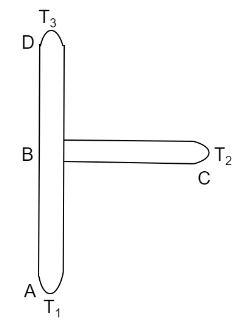
Three rods AB, BC and BD having thermal conductivities in the ratio $1:2:3$ and lengths in the ratio $2:1:1$ are joined as shown in Fig. The ends A, C and D are at temperature ${T_1}$, ${T_2}$ and ${T_3}$ respectively. Find the temperature of junction B. Assume steady state.

Answer
222.9k+ views
Hint: In this question, we are given the ratios of thermal conductivity and the lengths of the rods AB, BC, and CD. And we have to find the temperature of the junction B. First step is to let the thermal conductivity and length be $k$ and $l$. Now, apply Kirchhoff’s junction rule as the heat current is entering from AB and leaving from BC and BD. Solve further.
Formula used:
Kirchhoff’s Junction rule –
The sum of all currents entering a junction must equal the sum of all currents leaving the junction.
Heat current –
$H = \dfrac{{\Delta Q}}{{\Delta t}} = \dfrac{{kA\Delta T}}{d}$
$\Delta Q = $small amount of heat transferred in time $\Delta t$
$A = $ Cross- sectional area
$\Delta T = $Temperature difference
$k = $Thermal conductivity
$l = $ Length
Complete Step by Step Solution:
Let, the thermal conductivity and the length of the rods be $k$, $l$ respectively.
Given that, the thermal conductivity of the rods AB, BC and BD are in the ratio $1:2:3$ and the lengths in the ration $2:1:1$.
Therefore, the thermal conductivity of the rods AB, BC and BD will be $k$, $2k$ and $3k$
The lengths of the rods AB, BC and BD are $2l$, $l$ and $l$.
Let, T be the temperature at junction B.
Assuming, ${T_1} > T > {T_2}$ and $T > {T_3}$
Now, using Kirchhoff’s Junction rule
${\left. {\dfrac{{\Delta Q}}{{\Delta t}}} \right]_{AB}} = {\left. {\dfrac{{\Delta Q}}{{\Delta t}}} \right]_{BC}} + {\left. {\dfrac{{\Delta Q}}{{\Delta t}}} \right]_{BD}}$
$\dfrac{{kA\left( {{T_1} - T} \right)}}{{2l}} = \dfrac{{2kA\left( {T - {T_2}} \right)}}{l} + \dfrac{{3kA\left( {T - {T_3}} \right)}}{l}$
$\dfrac{{{T_1} - T}}{2} = 2\left( {T - {T_2}} \right) + 3\left( {T - {T_3}} \right)$
${T_1} - T = 10T - 4{T_2} - 6{T_3}$
$T = \dfrac{1}{{11}}\left( {{T_1} + 4{T_2} + 6{T_3}} \right)$
Hence, at steady state the temperature in the junction B is $\dfrac{1}{{11}}\left( {{T_1} + 4{T_2} + 6{T_3}} \right)$.
Note: The key concept involved in solving this problem is the good knowledge of Kirchhoff’s law. Students must remember that there are two laws. First is the junction rule and the second one is the loop rule. First one we have stated in the above solution and the loop rule states that the sum of all the potential differences (electric) around the loop is equal to zero.
Formula used:
Kirchhoff’s Junction rule –
The sum of all currents entering a junction must equal the sum of all currents leaving the junction.
Heat current –
$H = \dfrac{{\Delta Q}}{{\Delta t}} = \dfrac{{kA\Delta T}}{d}$
$\Delta Q = $small amount of heat transferred in time $\Delta t$
$A = $ Cross- sectional area
$\Delta T = $Temperature difference
$k = $Thermal conductivity
$l = $ Length
Complete Step by Step Solution:
Let, the thermal conductivity and the length of the rods be $k$, $l$ respectively.
Given that, the thermal conductivity of the rods AB, BC and BD are in the ratio $1:2:3$ and the lengths in the ration $2:1:1$.
Therefore, the thermal conductivity of the rods AB, BC and BD will be $k$, $2k$ and $3k$
The lengths of the rods AB, BC and BD are $2l$, $l$ and $l$.
Let, T be the temperature at junction B.
Assuming, ${T_1} > T > {T_2}$ and $T > {T_3}$
Now, using Kirchhoff’s Junction rule
${\left. {\dfrac{{\Delta Q}}{{\Delta t}}} \right]_{AB}} = {\left. {\dfrac{{\Delta Q}}{{\Delta t}}} \right]_{BC}} + {\left. {\dfrac{{\Delta Q}}{{\Delta t}}} \right]_{BD}}$
$\dfrac{{kA\left( {{T_1} - T} \right)}}{{2l}} = \dfrac{{2kA\left( {T - {T_2}} \right)}}{l} + \dfrac{{3kA\left( {T - {T_3}} \right)}}{l}$
$\dfrac{{{T_1} - T}}{2} = 2\left( {T - {T_2}} \right) + 3\left( {T - {T_3}} \right)$
${T_1} - T = 10T - 4{T_2} - 6{T_3}$
$T = \dfrac{1}{{11}}\left( {{T_1} + 4{T_2} + 6{T_3}} \right)$
Hence, at steady state the temperature in the junction B is $\dfrac{1}{{11}}\left( {{T_1} + 4{T_2} + 6{T_3}} \right)$.
Note: The key concept involved in solving this problem is the good knowledge of Kirchhoff’s law. Students must remember that there are two laws. First is the junction rule and the second one is the loop rule. First one we have stated in the above solution and the loop rule states that the sum of all the potential differences (electric) around the loop is equal to zero.
Recently Updated Pages
JEE General Topics in Chemistry Important Concepts and Tips

JEE Extractive Metallurgy Important Concepts and Tips for Exam Preparation

JEE Atomic Structure and Chemical Bonding important Concepts and Tips

JEE Amino Acids and Peptides Important Concepts and Tips for Exam Preparation

Electricity and Magnetism Explained: Key Concepts & Applications

JEE Energetics Important Concepts and Tips for Exam Preparation

Trending doubts
JEE Main 2026: Application Form Open, Exam Dates, Syllabus, Eligibility & Question Papers

Derivation of Equation of Trajectory Explained for Students

Hybridisation in Chemistry – Concept, Types & Applications

Understanding the Angle of Deviation in a Prism

How to Convert a Galvanometer into an Ammeter or Voltmeter

Degree of Dissociation: Meaning, Formula, Calculation & Uses

Other Pages
NCERT Solutions For Class 11 Chemistry Chapter 7 Redox Reaction

JEE Advanced Marks vs Ranks 2025: Understanding Category-wise Qualifying Marks and Previous Year Cut-offs

Hydrocarbons Class 11 Chemistry Chapter 9 CBSE Notes - 2025-26

Thermodynamics Class 11 Chemistry Chapter 5 CBSE Notes - 2025-26

NCERT Solutions ForClass 11 Chemistry Chapter Chapter 5 Thermodynamics

Equilibrium Class 11 Chemistry Chapter 6 CBSE Notes - 2025-26




